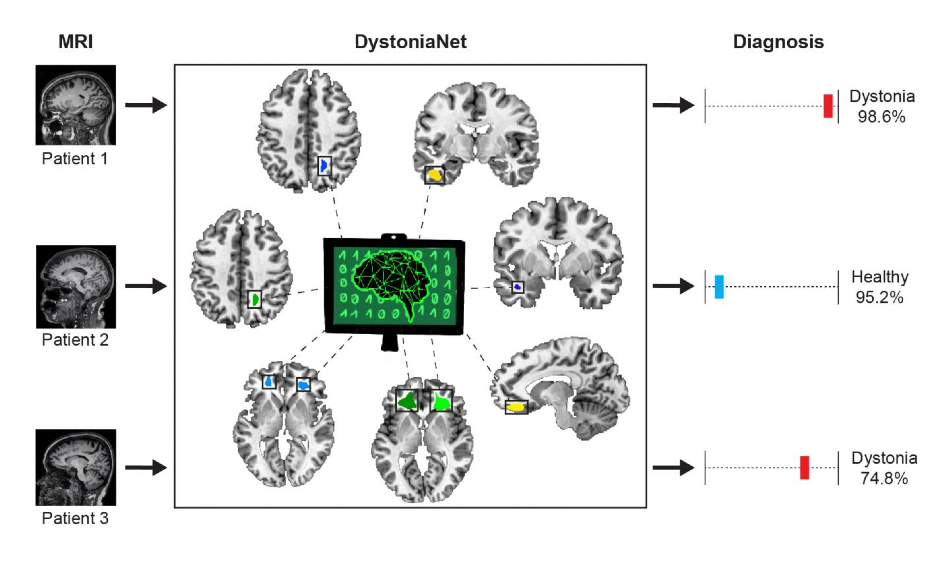Sep 29 2020
Scientists from Massachusetts Eye and Ear at Harvard Medical School have created an innovative diagnostic tool that is capable of detecting dystonia from MRI scans, the first-of-its-kind technology to allow an unbiased diagnosis of the disorder.
 A diagram of the DystoniaNet platform’s process in diagnosing dystonia from MRI. Image Credit: Mass Eye and Ear.
A diagram of the DystoniaNet platform’s process in diagnosing dystonia from MRI. Image Credit: Mass Eye and Ear.
Dystonia, a potentially disabling neurological condition, causes involuntary contractions of muscles, which result in abnormal postures and movements. This disorder is frequently misdiagnosed and can take nearly 10 years for people to receive an accurate diagnosis.
In new research published in the PNAS journal on September 28th, 2020, scientists have described the development of an AI-based deep learning platform, known as DystoniaNet, to compare the brain MRIs of 612 individuals, including 220 healthy persons and 392 patients suffering from three diverse forms of isolated focal dystonia.
The platform was able to diagnose dystonia with an accuracy of 98.8%. During the procedure, the team recognized a novel microstructural neural network biological marker of dystonia. With additional testing and validation, they hope that DystoniaNet can be effortlessly incorporated into clinical decision-making.
There is currently no biomarker of dystonia and no ‘gold standard’ test for its diagnosis. Because of this, many patients have to undergo unnecessary procedures and see different specialists until other diseases are ruled out and the diagnosis of dystonia is established.”
Kristina Simonyan, MD, PhD, Doctor of Medicine, and Director of Laryngology Research, Massachusetts Eye and Ear, Harvard Medical School
Dr Simonyan added, “There is a critical need to develop, validate and incorporate objective testing tools for the diagnosis of this neurological condition, and our results show that DystoniaNet may fill this gap.”
Dr Simonyan is the study’s senior author and Associate Neuroscientist at Massachusetts General Hospital. She is also the Associate Professor of Otolaryngology-Head and Neck Surgery at Harvard Medical School.
A Disorder Notoriously Difficult to Diagnose
Isolated or primary dystonia occurs in around 35 out of every 100,000 people. This prevalence is probably underestimated because of the existing challenges in diagnosing this disorder. In certain cases, dystonia can be caused by a neurological event, such as a stroke or Parkinson’s disease.
However, most of the isolated dystonia cases have no identified cause and impact a single group of muscles in the body. These supposed focal dystonias can result in disability and problems with the emotional and physical standard of living.
The research involved three of the most typical types of focal dystonia—laryngeal dystonia, defined by involuntary movements of the vocal cords that can cause problems with speech (also known as spasmodic dysphonia); cervical dystonia, which makes the neck muscles to contract and causes the neck to tilt in an abnormal manner; and blepharospasm, a focal dystonia of the eyelid that leads to involuntary twitching and forceful closure of eyelids.
Conventionally, a dystonia diagnosis involves clinical observations, stated Dr Simonyan. Former studies have discovered that the consensus on dystonia diagnosis between clinicians based on only clinical assessments is as low as 34% and have stated that around 50% of the cases are underdiagnosed or misdiagnosed at a first patient visit.
DystoniaNet Could be Integrated into Medical Decision-Making
The DystoniaNet platform uses deep learning, a specific type of AI algorithm, to examine data from each MRI and identify subtler variations in the structure of the brain. This platform is capable of detecting groups of abnormal structures in many parts of the brain that are said to control processing and motor commands.
It is not possible to view these small variations with the naked eye in MRI, and the patterns are only evident via the platform’s ability to capture 3D brain images and zoom into their microstructural specifics.
Our study suggests that the implementation of the DystoniaNet platform for dystonia diagnosis would be transformative for the clinical management of this disorder. Importantly, our platform was designed to be efficient and interpretable for clinicians, by providing the patient's diagnosis, the confidence of the AI in that diagnosis, and information about which brain structures are abnormal.
Davide Valeriani, PhD, First Study Author and Postdoctoral Research Fellow, Dystonia and Speech Motor Control Laboratory, Massachusetts Eye and Ear, Harvard Medical School
The patent-pending proprietary platform, DystoniaNet, was designed by Dr Simonyan and Dr Valeriani, along with Mass General Brigham Innovation. The novel technology deduces an MRI scan for a microstructural biomarker in just 0.36 seconds. Amazon Web Services computational cloud platform was used to train the DystoniaNet platform.
The team is confident this technology can be effortlessly adapted to the clinical setting, such as by integrating it into an electronic medical record or directly adding it to the MRI scanner software.
If the DystoniaNet platform indicates a high probability of dystonia in the MRI, a physician can utilize this data to assuredly help confirm the diagnosis, follow up future actions, and recommend a course of treatment without any delay.
While dystonia cannot be cured, certain treatments can help decrease the incidence of spasms associated with dystonia.
Upcoming studies will explore more types of dystonia and will involve trials at numerous hospitals to additionally validate the new DystoniaNet platform in more number of patients.
The study received funding and support from the National Institutes of Health (R01DC011805, R01DC012545, R01NS088160), Amazon Web Services via the Machine Learning Research Award, and a charitable gift by Keith and Bobbi Richardson.